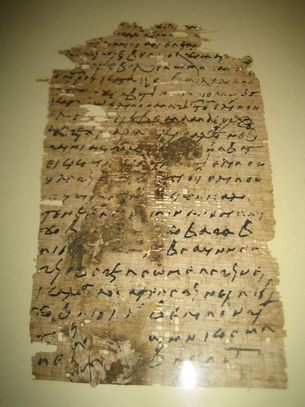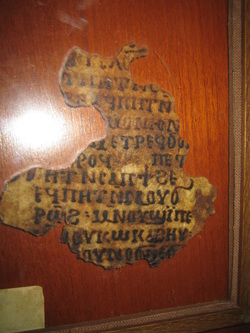 eBay item: 231403963111
eBay item: 231403963111 This week, we are back to eBay, with yet two more Coptic manuscripts. Both manuscripts are being sold by a seller located in Germany. According to the eBay description, both manuscripts are "from the collection of Dr. Christian Grand. Exported from [E]gypt ca. in 1950. (confirmed, with a clear provenance)." I cannot find any information on a Dr. Christian Grand, but it would certainly seem that his collection is a private one. It would be very helpful to know more about that "clear provenance" the seller mentions.
The first manuscript is a Coptic papyrus (see image above) written in a type of handwriting that papyrologists call "documentary." In other words, this is not a literary text: it is a document from everyday life, probably a private letter. Support for this designation (i.e., private letter) is found toward the end of the papyrus, where we find the Coptic phrase "shēn Kosma" ("son/daughter of Kosmas"). Kosmas is a very common name in Coptic documentary papyri from Egypt. So, it is not a liturgical piece, as the eBay description cautiously suggests. As for the date of this papyrus, it is almost impossible to know, since Coptic manuscripts are notoriously difficult to date. The 4th century date given, therefore, must be taken with a grain of salt.
 eBay item: 231397377003
eBay item: 231397377003 As a papyrologist who studies ancient Greek and Coptic manuscripts, I am quite interested in locating and identifying manuscripts such as the ones above that surface on the antiquities market. Many such manuscripts were purchased by private collectors in the early 20th century and they surface on the market every now and then. Usually, their appearance means that the original owner has died and that the owner's collection is being sold off by someone else (usually a family member). Alternatively, a seller may decide to sell his or her items for financial gain. Just in the last few weeks, we have seen quite a few papyri in online auctions, all from private collections of individuals who are otherwise unknown. And this prompts the question: Just how many ancient manuscripts are sitting in the basements, match boxes, drawers, safes, or shelves of private collectors around the globe? It is almost certain that, as I write this, many ancient manuscripts or fragments thereof are just sitting in the dark closets of their collectors, decaying and crumbling to pieces. The public needs to be aware of the importance of the preservation of antiquities, because once they are gone, they are gone forever.
To cite just one example, the famous papyrus codex of the Gospel of Judas, published in 2006, was stored by one of its owners in a safe-deposit box on Long Island for sixteen years, and then placed in a freezer by a potential buyer because this person thought that was the best way to preserve it! The results of these decisions were horrifying: the codex crumbled into many hundreds of tiny pieces and what was once a virtually complete codex was now badly deteriorated and difficult to restore (see the image here). There needs to be more control in the selling of antiquities to ensure proper preservation and conservation. And I'm not sure eBay is helping the situation, although these auctions are at least providing us with evidence of otherwise unknown antiquities.
In any case, what will ultimately happen to the two eBay manuscripts above? Will the buyer store it in his/her freezer? Will he/she put it in on his/her wall of prize collections, where it will stay for decades? Will it get lost accidentally in the shipping process? Will it get stolen from the collector's home?
Your guess is as good as mine
